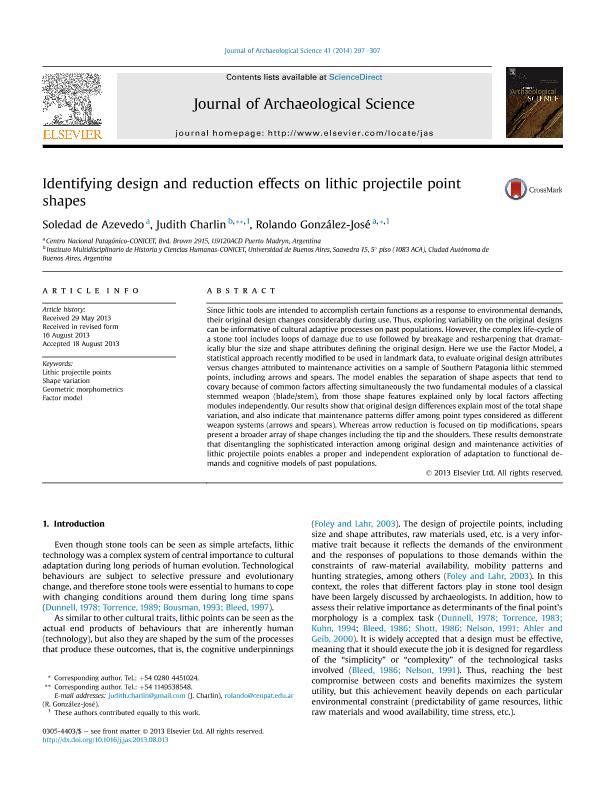Mostrar el registro sencillo del ítem
dc.contributor.author
de Azevedo, Soledad

dc.contributor.author
Charlin, Judith Emilce

dc.contributor.author
Gonzalez Jose, Rolando

dc.date.available
2015-12-28T19:04:29Z
dc.date.issued
2014-01
dc.identifier.citation
de Azevedo, Soledad; Charlin, Judith Emilce; Gonzalez Jose, Rolando; Identifying design and reduction effects on lithic projectile point shapes; Elsevier; Journal of Archaeological Science; 41; 1-2014; 297-307
dc.identifier.issn
0305-4403
dc.identifier.uri
http://hdl.handle.net/11336/3255
dc.description.abstract
Since lithic tools are intended to accomplish certain functions as a response to environmental demands, their original design changes considerably during use. Thus, exploring variability on the original designs can be informative of cultural adaptive processes on past populations. However, the complex life-cycle of a stone tool includes loops of damage due to use followed by breakage and resharpening that dramatically blur the size and shape attributes defining the original design. Here we use the Factor Model, a statistical approach recently modified to be used in landmark data, to evaluate original design attributes versus changes attributed to maintenance activities on a sample of Southern Patagonia lithic stemmed points, including arrows and spears. The model enables the separation of shape aspects that tend to covary because of common factors affecting simultaneously the two fundamental modules of a classical stemmed weapon (blade/stem), from those shape features explained only by local factors affecting modules independently. Our results show that original design differences explain most of the total shape variation, and also indicate that maintenance patterns differ among point types considered as different weapon systems (arrows and spears). Whereas arrow reduction is focused on tip modifications, spears present a broader array of shape changes including the tip and the shoulders. These results demonstrate that disentangling the sophisticated interaction among original design and maintenance activities of lithic projectile points enables a proper and independent exploration of adaptation to functional demands and cognitive models of past populations.
dc.format
application/pdf
dc.language.iso
eng
dc.publisher
Elsevier

dc.rights
info:eu-repo/semantics/openAccess
dc.rights.uri
https://creativecommons.org/licenses/by-nc-nd/2.5/ar/
dc.subject
Lithic Projectile Points
dc.subject
Shape Variation
dc.subject
Geometric Morphometrics
dc.subject
Factor Model
dc.subject.classification
Paleontología

dc.subject.classification
Ciencias de la Tierra y relacionadas con el Medio Ambiente

dc.subject.classification
CIENCIAS NATURALES Y EXACTAS

dc.title
Identifying design and reduction effects on lithic projectile point shapes
dc.type
info:eu-repo/semantics/article
dc.type
info:ar-repo/semantics/artículo
dc.type
info:eu-repo/semantics/publishedVersion
dc.date.updated
2016-03-30 10:35:44.97925-03
dc.journal.volume
41
dc.journal.pagination
297-307
dc.journal.pais
Países Bajos

dc.journal.ciudad
Amsterdam
dc.description.fil
Fil: de Azevedo, Soledad. Consejo Nacional de Investigaciones Científicas y Técnicas. Centro Nacional Patagónico; Argentina
dc.description.fil
Fil: Charlin, Judith Emilce. Consejo Nacional de Investigaciones Científicas y Técnicas. Oficina de Coordinación Administrativa Saavedra 15. Instituto Multidisciplinario de Historia y Ciencias Humanas; Argentina
dc.description.fil
Fil: Gonzalez Jose, Rolando. Consejo Nacional de Investigaciones Científicas y Técnicas. Centro Nacional Patagónico; Argentina
dc.journal.title
Journal of Archaeological Science

dc.relation.alternativeid
info:eu-repo/semantics/altIdentifier/doi/http://dx.doi.org/10.1016/j.jas.2013.08.013
dc.relation.alternativeid
info:eu-repo/semantics/altIdentifier/url/http://www.sciencedirect.com/science/article/pii/S0305440313003026
Archivos asociados
